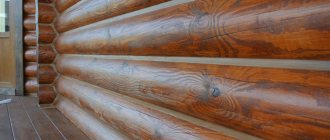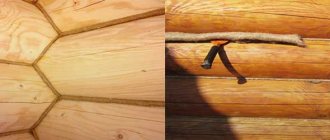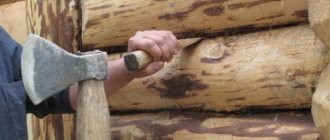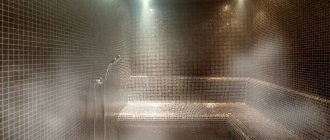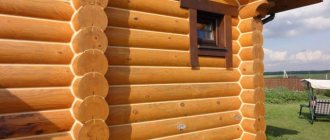Building a bathhouse or any other building from a log frame is only half the battle. There is another important job that requires high-quality performance - caulking a bathhouse, which consists of sealing all the cracks to prevent heat loss and wind blowing.
The material for caulking a bath can be chosen from two categories - natural materials (jute, moss, tow) or their synthetic analogues. How to caulk the log house of a bathhouse?
How to properly install inter-crown insulation?
Intercrown insulation
spread over the beam and attached to it using a stapler, after which the log is laid. Also, do not forget to use dowels for the timber, so that the house will stand for a long time and will not be damaged.
Interesting materials:
Is it possible to make a fire on the territory of the reserve? Is it possible to make a fire near the river? Is it possible to make a fire in young coniferous forests? Is it possible to have a fire in the forest in 2022? Is it possible to make a fire in the forest Belarus 2022? Is it possible to make a fire in a barbecue? Is it possible to make a fire? Is it possible to make fires in 2022? Is it possible to make fires outdoors? Is it possible to grow orchids?
Seam sealing materials
There are several types of materials that are suitable for high-quality finishing of joints. The main requirement is absolute resistance to moisture. Also, the selected material must be durable, not afraid of long-term use, and at the same time be easily deformed in order to seal all the seams tightly.
There are several types of seals:
synthetic fibers, as a rule, we are talking about polypropylene, which can be produced in rolls on a woven or non-woven base;
organic material, the main ones being jute and flax tow;
Suitable varieties of moss are separately identified, since this material combines the characteristics of synthetics and organics, despite its completely natural composition.
Attention! Typically, the material for caulking is selected based on financial capabilities. But it is also recommended to take into account factors such as the rate of shrinkage of the bath and the width of the seams. This depends on the type of material used to construct the structure.
Installation Tips
To get the job done quickly and with a minimum of effort, you should follow a number of recommendations.
- The fastest way to install is a tape seal. To lay it, it is enough to measure the size of the space between the logs to understand what width of the tape to use for driving. After this, it is necessary to tightly push one end of the fibers from one end of the log house, gradually unwinding the tape towards the other end.
- Be sure to ensure that the fibers do not twist, tear or deform during unwinding. At the end, leave a margin of 25-30 cm and cut the tape. After that, we simply carefully push it into the slot. The tape should tightly fill the entire space and not sag. But at the same time, try not to tear or stretch the fibers, the quality of installation depends on this.
- To make the work go faster and better, you should start caulking the bathhouse from a wide edge, moving towards a narrower one. It is necessary to hammer the material with a hammer and a wooden spatula, but it is important that they have rubber tips so as not to cut the fibers. Simply tapping lightly should place the tape inside the gap.
- Experts recommend going through each seam with a hammer and spatula at least three times. This will allow you to evenly distribute the tape between the crowns and prevent the fabric from sagging. For each pass, a new piece of tape is taken!
- The seams should be passed from the bottom level, gradually moving along the entire perimeter. Only after this can you move higher. If you start caulking just one wall, there will be a serious difference in the height of the structure, which will lead to problems in long-term work on sealing seams. In addition, this form of work can cause the top rows of the bath to break.
- If installation is carried out in bunches, which is more often the case when using tow or moss, it is necessary to pre-treat the seams with a special compound. It is best to rub a solution of alcohol formaldehyde and linseed oil into the cracks. Sometimes bundles are additionally processed with the mixture.
- Work should be carried out according to the same scheme as in the case of tape material. From the bundles you need to weave small ropes with a thickness of 2-4 mm. Such a cord is pushed into the gap using a spatula; you cannot use a hammer!
- The next layer of rope should be thicker than the previous one; for this it is twisted to a thickness of 3-4 mm. In the third pass, the cord may already be 5-8 mm thick. If individual places are very wide, additional beams are placed in them. In this case, they must be treated with rubber glue. This is necessary for reliable fixation, since they are not laid along the entire length of the inter-crown space.
Attention! If beams were used during processing, after the seams are completely sealed, they can be additionally treated with acrylic paint. It will extend the life of the material and protect against moisture.
Linen
Flax is a plant growing in Russia, Belarus, and Europe. Linen is very durable, has heat-saving, heat-transfer, and antiseptic properties. Linen fiber is used to produce fabrics that are used in various branches of light industry. Insulation (flax wool and tow) is made from flax. Ligin in flax is only 7%, which makes it unstable to the conditions of our climate. Rolled insulation - flax wool - is used as insulation in wooden houses and bathhouses. This is a special material for inter-crown gaskets. Linen is the most unstable insulation material. The service life of flax fiber is 1-3 years. It quickly rots when moisture gets on it and quickly disintegrates. Birds and rodents love this material.
It is loved by bedbugs, moths and many other insects. In view of this, it is necessary to antisepticize wood and all lumber. The roof extension in buildings where flax was used as insulation must be at least a meter. The main advantage of this material is environmental safety and excellent thermal conductivity.
Flax fiber insulation has proven itself to be excellent when caulking seams between logs, filling gaps when installing windows, doors, and insulating roofs, floors and ceiling surfaces. Linen is an excellent soundproofing material.
Features of moss and tow
Most often, when it is necessary to caulk a bathhouse, moss is chosen. It is universal and can be used in any climatic conditions. Before starting work, it is important to prepare the moss well. It is collected, completely cleaned and dried, but not completely. The bundles should remain slightly damp.
The quality of processing should be assessed by the structure of the moss. As soon as it becomes springy and strong, reminiscent of wire, drying should be stopped and you can begin to caulk the bathhouse.
Attention! While drying the moss, it should be constantly turned over so that the drying proceeds evenly. The quality of the finished fiber depends on this.
It is recommended to use moss immediately after the construction of the main structure. This will simplify processing and give better results. After you start using the bathhouse, you should go through all the seams again with moss after 1-2 years.
Expert opinion
Lovkachev Boris Petrovich
Bath master who knows everything about steaming
Attention! Do not think that moss has a bactericidal effect and is not afraid of mold. This is all a myth and fabrication of those who promote natural finishing materials. If moss is not dried well, it can quickly become moldy. But at the same time, you can’t overdry it either - it will become very brittle.
Linen tow is considered more reliable and safe than moss and much better quality than jute ropes. Linen is very soft and easily damaged when hammering into seams, so you need to work with it carefully, hammering in the voids as gently as possible.
It is most convenient to use flax tow when processing rounded timber, but other designs are also not prohibited, the work will simply be more labor-intensive.
When filling the voids, flax, as a rule, is twisted into small ropes, which are then used to caulk the bathhouse.
The main advantage of the material is its springiness and the ability to adapt to voids, taking into account the shrinkage of the structure. Flax owes these properties to the non-drying oils that are found even in the processed plant.
The main disadvantage of flax tow is its short service life in the bathhouse. Usually, re-treatment of the inter-crown space is required after 2-3 years.
How to properly caulk a bathhouse: with moss, flax fiber, tow, felt
Caulking of any wooden bathhouse must be done in two stages: after completion of construction and after a year of shrinkage. For the work, the same insulation is used, which is laid between the links during construction. Traditionally, for caulking baths, they use: moss, felt, tow, and hemp. Readers will learn how to properly caulk a bathhouse with their own hands, what tools are needed and the intricacies of the work by studying the article to the end.
The bathhouse will have to be caulked in any case. The main thing is to do the work carefully.
Execution technology
The caulking of the bath is carried out according to the established algorithm. The process is simple, but time-consuming. One person risks spending up to eighty hours on a 4x5 meter building. First of all, the outer part of the structure is treated.
Important! The largest gaps form in corners and joints, so these places are given more attention when caulking. When re-inspecting them, they are examined first.
During primary caulking, the hanging parts of the raw material are picked up and pushed inside. All areas are worked on gradually, meter by meter. This is the only way to achieve uniform filling of the cracks. Hammers, mallets, and spatulas are used in the work. The material must be hammered to an elastic state. After completion of the work, the structure is inspected, new cracks are filled with material. The more attentive the master is, the fewer mistakes will be made during the first caulking.
Professional caulking
The construction company is engaged in the construction of turnkey wooden baths. Caulking a bath is an integral part of the process, which is carried out under strict control at every stage. Specialists lay the material, fill cracks and gaps evenly. We use only high-quality material from a trusted manufacturer to completely eliminate the possibility of errors. At the design stage, material and time costs are calculated.
To get acquainted with the company's work, you can view the catalog of completed baths. Get a consultation, ask questions at the specified phone number, or fill out the feedback form. Entrust the work to professionals with extensive experience!
What is the time frame for caulking baths?
When can the final stage of insulation begin after the construction of the log house?
If the frame was laid with moss, then it is necessary to cut off its excess. Then the remaining material is tucked into the cracks and carefully pushed inside. All. You should not be particularly zealous - the first caulking will take place six months after the completion of construction. During this time, the tree will finally shrink and excess moisture will evaporate. After completing the first caulking, you can install windows and doors.
A year after the first caulking, the second one is carried out as the last stage of insulation. After about five years, another caulking procedure may be used, which is optional and depends on what specific materials were used.
How can you caulk a log house?
There are natural materials for caulking and artificial ones. The first include tow, hemp, jute, moss, and so on. The latter include industrial sealants. Sealants are easier to work with and apply quickly. As a rule, in order to reduce their consumption, a cord is laid in the inter-crown gap, and the sealant, which is distributed with a special spatula before hardening, is applied on top of it.
However, sealants have a number of disadvantages:
You can learn more about how to operate the sealant by watching the available video material. A simple tablespoon is perfect for distributing the sealing agent.
If, when determining how to caulk a bathhouse, you chose a sealant, then carefully study the instructions and make sure that it can be used with exactly the type of wood from which your log house is made, that it is suitable for your region, and also has all the necessary characteristics.
It is advisable to use a synthetic sealant for a log bathhouse if it is used to close caulked cracks. After double caulking the log house with tow, moss or jute, wait until the log house finally settles and reaches working dimensions. Next, a cord is inserted into the seams and covered with sealant.
Each of the natural materials for caulking has its own positive and negative qualities, and preparatory measures are required in any case.
Moss is considered the most common, time-tested material for caulking. It has been used for hundreds of years. Currently, there are many other materials, but they all have slightly worse characteristics. True, new materials are easier to operate, and they also have such positive qualities as antibacterial properties and special resistance to rotting.
Before caulking a log bathhouse with moss, it must be dried and soaked right before use. This action will give the moss fibers elasticity. The moss is laid out in a layer and leveled so that its ends hang down on both sides of the beam. After all the logs have been laid out, the excess moss fibers are shortened, and what remains is wrapped and tucked into the cracks. Thus, the first stage of caulking the log house is carried out. Further stages of caulking will be continued after a year and a half.
Recently, builders are increasingly asking the question of how to caulk a bathhouse with jute. Given that we mean rolled material. Jute fiber has excellent thermal insulation properties and contains natural binding resins. Jute is practically not afraid of moisture, and very rarely becomes unusable due to rotting. Even in conditions of high humidity it does not get wet.
Jute comes in several varieties:
Video description
Watch a video on how to caulk a log house with jute:
And the last thing we will consider is caulking the log house with sealant. A sealing cord is first laid in the gap, and then the entire gap is blown out with foam from a mounting gun. You can also seal large cracks in logs.
Then the seams that have not yet dried are moistened with water and carefully smoothed with a brush or spatula. All excess foam is removed.
The easiest way to caulk a log house with sealant is Source krasiviy-dom.ru
Specifics
The simple process of caulking takes a lot of time and requires endurance. The work is represented by the monotonous driving of material into the gaps and is carried out either during the process of installing walls or upon completion of construction work. It performs the following tasks:
- closes cracks;
- minimizes the appearance of drafts;
- helps maintain temperature;
- enhances thermal insulation;
- does not allow the structure to warp after shrinkage;
- reduces the negative impact of moisture and the environment.
Natural and synthetic materials are used to fill gaps. For reliability, sometimes methods are combined and, after laying the material, they are secured with sealants. It is necessary to caulk the bathhouse to prevent rotting and destruction of the logs. Like the structure itself, the materials do not contain toxic substances and are environmentally friendly.
Features of synthetic material
Nowadays synthetic and semi-synthetic materials are actively promoted on the market. Typically, a composite cord is used to seal the seams. It consists of an equal amount of polypropylene threads and wool. This option is great for structures that begin to dry out during use, causing the seams to expand.
But such materials do not tolerate exposure to sunlight well, which is why they begin to crumble, especially when using completely synthetic fibers. Work using ropes is lengthy and requires some skill, since the fibers are difficult to deform.
Despite the active promotion of synthetic and semi-synthetic materials, when building a bathhouse in an area with a lot of sunny days, it is better to give preference to natural fibers.
Video description
This video explains in detail how to caulk log houses:
For caulking of log houses, they try to use wooden tools. They are softer and do not leave damage on the logs.
It is advisable to caulk the log house from the inside and outside. You need to start from the corners, you need to go from bottom to top, caulking each row to the end. If you work on the walls separately, you can warp the entire building.
You need to start caulking the log house from the bottom rowsSource psk.baraholka.com.ru

